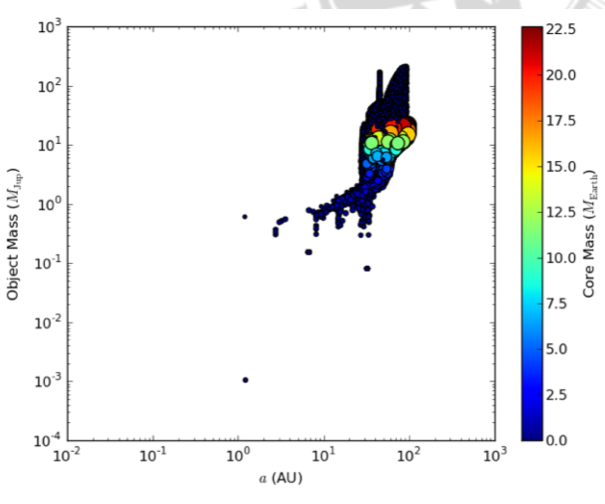Avid readers may remember a few years ago I blogged about the statistics of objects formed by disc fragmentation. In our paper, we looked at tidal downsizing, to see if big fluffy disc fragments with masses bigger than Jupiter could form solid cores and lose their gas to become objects of Neptune, maybe even Earth masses. We created what’s known as a population synthesis model – this is essentially a way of running lots of simulations very quickly to get lots of output data, in our case lots of fragments which have evolved to form objects (or not, as the case may be).
We discovered that making terrestrial planets is very hard – after producing millions of disc fragmentation events in our model, only one of those objects went on to make an Earthlike body. In fact, we lost about half of the fragments to tidal disruption – they were ripped to shreds by getting too close to their star before they had become fully formed. Most of the surviving fragments were giant planets or brown dwarfs orbiting at about Neptune’s distance from the Sun.

But, our model was incomplete. We wanted to run millions of simulations, so we had to simplify the physics quite a bit. This is a common problem for population synthesis models, as they need to run to completion without it taking millions of years! The only way to beat it is by using clever algorithms and lots of supercomputer power.
One of the most important pieces of physics we jettisoned early on was fragment-fragment interactions. Our discs were fragmenting to form multiple objects with relatively strong gravitational fields – they should be pulling on each other and changing their orbits. Also, the systems were likely to still be in their parent star cluster. All those nearby stars would have a gravitational effect as well!
Instead, our fragments coast along on nice circular orbits. We didn’t add gravitational interactions to the model because it would have needed extra computational power, and would have taken much longer to produce results. Also, we knew that in the simulation, the disc would have been the biggest nearby source of gravity, and would have acted to smooth out these orbital changes.
But eventually, the disc will disappear. Then what happens? We decided to run our models through N Body simulations to find out. With the help of Richard Parker, we placed our systems into his star cluster simulations, and we ran separate simulations to find out whether the planetary systems the model produced were stable.

So what did happen? One thing that happened quite a lot (about 25% of the time) is that a planet or brown dwarf gets ejected from the system. This means that if disc fragmentation happens regularly, we should see lots of free floating planets! Many of the bodies still orbit quite far from the star, but they now have very eccentric orbits. We know that some exoplanets have very eccentric orbits, like HD 8606b, so that is a sensible outcome. Our simulations can now give us some predictions for what we should see with the next generation of direct imaging surveys, and we are working with observers to figure out whether our predictions match up with what they are now seeing.
Some, but not many, of the bodies get pushed very close to the star, probably close enough to become Hot Jupiters. This is where it gets interesting, because these will look very similar to Hot Jupiters formed by other planet formation mechanisms, like core accretion. How do we tell them apart? This is something we’re working on right now, and I hope to tell you more about it soon.

